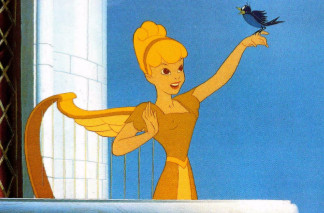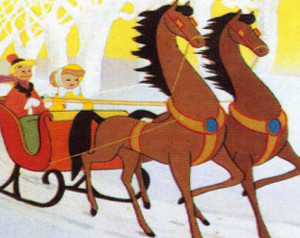Jim on Film
Page 5 of 7

Fun and Fancy Free
(c) Disney
But even in scenes without the elaborate multiplane camera or without inventive abstract images, these are visually stunning films, leaving one wish to see all of them restored as Fun and Fancy Free and Melody Time have been. They are marked by bright, rich colors and creative designs.
Oddly enough, in all these films, the only apparent re-use of animation is some dancing animation of Donald Duck and Joe Carioca in Blame It on the Samba from Melody Time and some bouncing instruments and rhythms which likely came from The Three Caballeros as well. And while there are a few similar character designs, such as in Grace Martin, Slue Foot Sue, and Katrina Van Tassle, there is very little of such obvious cost-cutting measures apparent.
Of all the edits made to the Disney animated features, the cut to Make Mine Music is most damaging. With Melody Time, the program starts with the boisterous Once Upon a Wintertime. It’s an energetic and colorful start to the program, quickly drawing the viewer into the film, much as an up-tempo song is often used to open a stage musical. Make Mine Music starts as such as well, with the funny and energetic The Martins and the Coys, but as it is in its edited version, it begins with the visually amazing Blue Bayou. The problem is that Blue Bayou starts off the movie not with a bang but with a sigh. It really isn’t until All the Cats Join In that there is anything to really bite into.
Another realization was that throughout the films of this period, there’s a heavy reliance on narration; however, the filmmakers are experimenting with it throughout this time. Interestingly, while narration in films (and stage works for that matter) often seems redundant and tiresome, that is never the case here. There’s a more traditional style of narration used in the Goofy section of Saludos Amigos (definitely first used in The Reluctant Dragon). But there’s also narration where the narrator comments on the action instead of just telling it (like in Pablo, the Cold-Blooded Penguin) and where the characters react to what the narrator says (Pedro, The Flying Gauchito, Peter and the Wolf). But with Bongo, there’s the style where the narrator sings and speaks for the characters (which was also done in Pecos Bill from Melody Time and in The Adventures of Ichabod and Mister Toad). Then in Mickey and the Beanstalk, the narrators tell what’s happening and provide commentary on the action. So, even though these films are not the glorious single-story features of the early 1940s, Disney is still experimenting and playing with styles. He’s not settling for what has been done before or what is easiest to do.
During this time, there’s also the experimentation with rhyming narration. In terms of the features, it first appears in Mickey and the Beanstalk from Fun and Fancy Free, followed by Johnny Appleseed in Melody Time, and The Adventures of Ichabod and Mister Toad (note that the rhyming from Casey at the Bat in Make Mine Music comes from the original poem). This is an interesting technique to use because successful use of rhyme is not an easy achievement, but it provides a musical quality to the narration. Again, it seems like another seemingly unnecessary frill that could have been cut from these features if they were only intended to be rushed out for an easy source of revenue.
A byproduct of this reliance on narration is that the animation of these segments relies heavily on pantomime because the characters are often communicating without the benefit of speaking their own words. This is probably most apparent in The Legend of Sleepy Hollow, where Ichabod is masterfully animated (even once pulling a Gideon-like action) without getting a chance to speak his mind.
In watching these films, there is also a progression of techniques and visual style. For example, in Pink Elephants on Parade, there is the use of colored outlines over black to depict characters, a technique which would come to use again to portray the emotional realism in the battle between Bambi and the young buck. This would again be used on a wistful Joe Carioca in The Three Caballeros.

Melody Time
(c) Disney
Stylistically, there is an almost immediate move from the intricate artwork in the early films, but there is a progression toward the use of Mary Blair’s designs. If The Martins and the Coys and Casey at the Bat lack distinctive design, every segment of Melody Time is a move toward something more unique, a transition which seems to begin in Fun and Fancy Free. Bongo has a brighter palette of colors than most of the previous single-story features, as does Mickey and the Beanstalk. It would be in Melody Time that the prominent use of the rich colors, lines, and shapes associated with Mary Blair in Once Upon a Wintertime and Johnny Appleseed would be used, which would be applied even more strongly in the Legend of Sleepy Hollow section of The Adventures of Ichabod and Mister Toad. This, of course, was a design style that heavily influenced the art direction of Cinderella, Alice in Wonderland, and Peter Pan as well.
Current critical reaction to Make Mine Music is that the film waivers unsteadily between the artsy portions to the more popular, story-driven portions. Oddly enough, in Fantasia, it is the artsy portions that drive the critics to praise it so highly.
Keeping this in mind and considering that it has been said that critics of the time commented that Disney should make a version of Fantasia with contemporary music, it could shed new light on, particularly, Make Mine Music, if not Melody Time as well.
